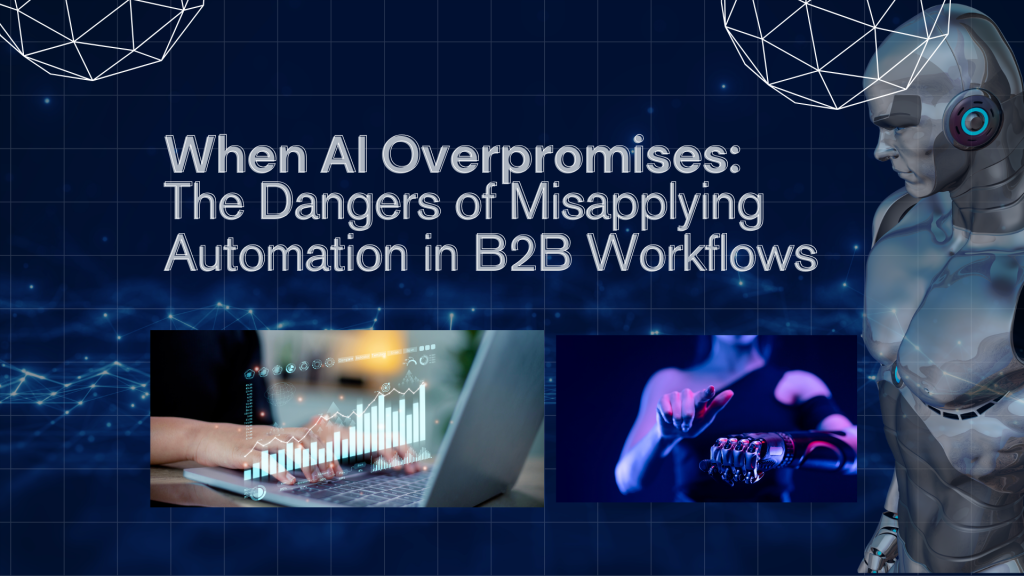In today’s competitive B2B landscape, the allure of AI and automation is hard to ignore. Promises of cost savings, faster processes, reduced human error, and scalable operations are driving organizations to integrate AI into everything from customer service to procurement. However, as more businesses jump on the AI bandwagon, a critical problem is surfacing: misapplication of automation technologies that do more harm than good.
When B2B companies deploy AI tools without clear use-cases, realistic expectations, or properly integrated systems, they risk breaking complex workflows, damaging client relationships, and wasting millions in implementation costs. This blog unpacks why automation isn’t a magic wand and what companies must consider before they automate anything.
The Hype Cycle: Why B2B Firms Are Falling for Overpromised AI –
AI vendors and consultants often paint an overly optimistic picture. From AI-powered CRMs to automated lead scoring and invoice processing bots, the sales pitch is always the same: smarter decisions, less human intervention, better results. But in reality, many B2B processes are too nuanced or fragmented for off-the-shelf automation.
For example, AI can misclassify customer queries, mishandle exception cases in procurement, or misinterpret financial anomalies, leading to more work — not less — for human teams. The problem isn’t AI itself; it’s the misalignment between automation capabilities and real-world B2B complexities.
Context Matters: Automation Without Process Maturity Backfires –
One of the biggest pitfalls is automating processes that are not yet mature or standardized. Many B2B firms have fragmented legacy systems, inconsistent data sources, or manual workflows that vary by region or team. Trying to automate such processes leads to chaos, not efficiency.
Before automation, companies need to assess:
- Is the current process standardized and well-documented?
- Are the data inputs clean, consistent, and machine-readable?
- Can edge cases be handled without human intervention?
Without this foundational work, AI only amplifies existing inefficiencies and creates new failure points that are harder to detect and debug.
When AI Hurts Customer Experience Instead of Helping It –
In B2B industries, customer relationships are long-term and high-stakes. A misstep in a contract negotiation, late delivery, or miscommunication in a support ticket can result in losing a multi-million dollar account.
Chatbots that don’t escalate complex issues, AI-driven systems that misinterpret service-level agreements (SLAs), or predictive tools that push irrelevant recommendations — these are all examples of automation hurting the trust and personalization that B2B clients expect.
Poorly applied AI in customer-facing processes can:
- Damage the brand’s reputation
- Increase churn among enterprise clients
- Lower Net Promoter Scores (NPS)
The Invisible Cost of Maintaining Misaligned Automation –
Most B2B companies underestimate the ongoing cost of maintaining, updating, and monitoring AI-based systems. These are not “set it and forget it” tools — they require constant data updates, retraining of models, human supervision, and integration adjustments.
Without a dedicated team or clear ownership, automation systems become brittle. Worse, when things go wrong, they often do so silently — misrouting orders, misclassifying client tiers, or skipping invoice approvals — leading to financial and operational consequences that may take weeks or months to identify.
A Strategic Approach: When and How to Automate B2B Workflows –
Instead of blindly adopting automation, B2B leaders must take a strategic, layered approach. Not every process needs to be automated — and not every automation needs to use AI. Some tasks may benefit more from simple rule-based systems, while others require hybrid human-AI collaboration.
Before automating, B2B organizations should:
- Conduct a process audit to identify maturity and automation potential
- Involve cross-functional teams (IT, operations, legal, sales) in decision-making
- Start with pilot programs to measure ROI before full-scale deployment
Conclusion –
AI and automation hold undeniable potential in the B2B world — but only when applied with precision, purpose, and process discipline. Misapplied automation creates more problems than it solves, from broken workflows to alienated clients and rising tech debt.
Rather than chasing the AI hype, B2B companies need to focus on business outcomes, understand their internal capabilities, and prioritize thoughtful implementation over speed. The goal shouldn’t be to automate everything — it should be to automate the right things, the right way, at the right time.

